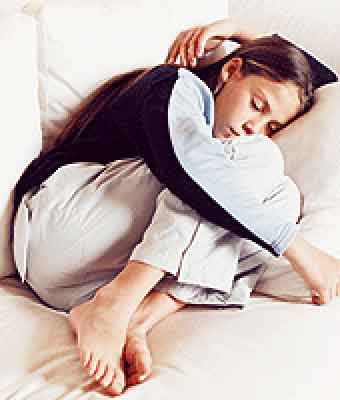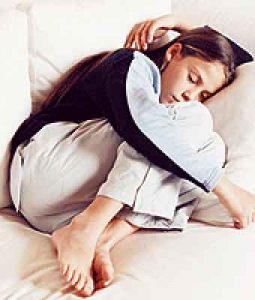

اثر طب سوزنى برای درمان درد های قاعدگی
اثر طب سوزنى برای درمان درد های قاعدگی
درد های قاعدگی یا دردهای پریود که به آن اصطلاحا (دیسمنوره) گفته می شود دردهایی هستند شدید، ضربان دار، تیز و سوزشی که اغلب در قسمت پایین شکم و نیز در ناحیه ران ها احساس میشوند .
از نظر طب غربی علت این دردهای قاعدگی اغلب نا مشخص می باشند و برای تسکین آنها نیز از داروهای ضد التهاب غیراستروئیدی که دارای عوارض جانبی زیادی نیز می باشند استفاده می گردد.
در حقیقت صدها سال است که از
طب سوزنی برای درمان دردهای قاعدگی در چین استفاده می شود. از نظر طب سوزنی کبد نقش مهمی در بروز این دردهای قاعدگی ایفاء می کند . مریدین کبد در طب سوزنی ازانگشت شست پا شروع شده واز ناحیه داخلی ران ها به سمت دستگاه تناسلی رفته وازآنجا به کبد و پستانها می رود. متخصصین طب سوزنی با استفاده از نقاطی از مریدین کبد می توانند دردهای قاعدگی را در خانم ها درمان نمایند.
Dysmenorrhoea is painful cramps originating in the uterus just prior to or during menstruation. It can be primary (i.e. without any organic pathology) or secondary (i.e. associated with a pathological condition, such as endometriosis or ovarian cysts). The pain usually lasts between 8 and 72 hours.(Fraser 1992)
Adolescent girls are more likely than older women to have primary dysmenorrhoea because the condition can get better with age.
Secondary dysmenorrhoea tends to be less common in adolescents, as onset of causative conditions may not have occurred yet. Estimates suggest that around 25-50% of adult women and about 75% of adolescents experience pain with menstruation, and some 5-20% report severe pain that prevents them from carrying on with their usual activities.(Zondervan 1998; Harlow 2004)
The longer the mean duration of menstruation the more severe the dysmenorrhoea. Also, younger age at menarche and cigarette smoking have been associated with dysmenorrhoea.(Harlow 1996; Sundell 1990)
Conventional treatment is aimed at relieving pain and includes NSAIDs, the oral contraceptive pill, depo-medroxyprogesterone acetate, levonorgestrel-releasing intrauterine device, danazol and leuprolide acetate.
How acupuncture can help
Recent systematic reviews of randomised controlled trials (RCTs) found that both acupuncture (Cho 2010a) and acupressure (Cho 2010b) are effective for primary dysmenorrhoea, providing significantly more pain relief than pharmacological treatments. Comparisons of acupuncture with sham acupuncture produced variable results and no significant difference overall (Cho 2010a).
This is consistent with the viewpoint that sham controls are active interventions, not placebos, providing unreliable results with a tendency to underestimate acupuncture’s effects (Lundeburg 2009; Sherman 2009). Two earlier systematic reviews (Yang 2008; Proctor 2002) found a lack of high quality trials on acupuncture for dysmenorrhoea and so could not draw firm conclusions. Since then there have been further RCTs, especially from China (Wong 2010; Chen 2010; Zhu 2010; Wang 2009),
hence the stronger conclusions in the 2010 reviews. The most compelling evidence comes from a large, high quality German trial that also found acupuncture to be cost-effective (Witt 2008).
Also see our other factsheets on Premenstrual syndrome and Endometriosis. For other gynaecological conditions the research base is scanty (Smith 2010). For example, a systematic review of trials on acupuncture for fibroids found no trials that fit their inclusion criteria (Zhang 2010). (see Table overleaf)
Acupuncture has long been used in China for treating premenstrual pain, but controlled scientific studies into its efficacy have only begun in recent years.
One such study, published in the journal Evidence-based Complimentary and Alternative Medicine in 2010, focused on women who had been suffering from moderate to severe dysmenorrhea for at least one year, and whose pain was resistant to NSAID treatment. دکتر فرهاد همت خواه
All the women in the study had declined treatment with oral contraceptives, which is one of the first treatments typically prescribed by doctors.
The researchers found that of the 15 women included in the study, 13 experienced significant pain reduction and reduced their use of NSAIDs following acupuncture treatment. Acupuncture appeared to be most effective at reducing pain in women with primary dysmenorrhea.
Another study conducted by researchers from the Shandong Academy of Chinese Medicine and published in the Chinese Journal of Integrative Medicine in 2011, followed 80 women with primary dysmenorrhea over three complete menstrual cycles. Women received either no acupuncture, an acupuncture treatment during their dysmenorrhea symptoms (“immediate acupuncture”) or an acupuncture treatment prior to the onset of their periods (“preconditioning acupuncture”). The researchers found that preconditioning acupuncture reduced both the severity and length of dysmenorrhea symptoms significantly better than either no acupuncture or immediate acupuncture.

